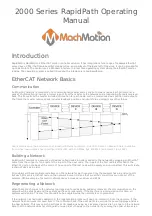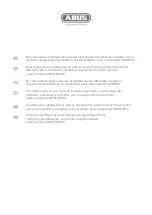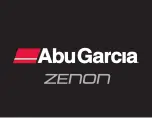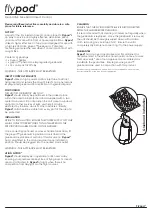
125
Refrigeration Maintenance
Evacuation
Evacuation is Important and is Critical to System
Performance!
It has been determined through testing and system
analysis that refrigeration systems which contain
non-condensables such as nitrogen and/or air can
be overcharged with refrigerant when charged
using the sight glass method. An overcharge of
refrigerant will cause compressor damage.
Therefore, Thermo King recommends that all
repairs to the refrigeration system include the
removal and reclamation (cleaning) of the
refrigerant, followed by a thorough evacuation
using the proper tools and procedures. (See
attached tool list and evacuation procedures.)
The primary objective of evacuation is to bring
the system’s pressure to a low micron level to
ensure the removal of moisture and
non-condensables. There are however, certain
other principles which must be observed. These
are:
•
Evacuate from 3-points to access both sides of
check valves and solenoids. Energize
solenoids during evacuation to prevent
trapping of refrigerant or non-condensables.
•
Always leave service valve caps on during
evacuation and do not exercise the valve stems
while the unit is in a deep vacuum. Packing
glands on older valves are prone to leak.
•
Never attempt evacuation without a micron or
vacuum gauge. The micron gauge will help
determine:
a. If the pump is capable of pulling a deep
vacuum.
b. When the vacuum pump oil is
contaminated.
c. If the vacuum hoses and valves are leak
free.
d. If the unit is leak free.
e. How long you should evacuate the unit.
f.
That the unit is still in a deep vacuum
before any lines are disconnected or
refrigerant is added.
NOTE: The attached evacuation procedures
have been written to be used with the Thermo
King Evacuation System (see P/N 204-725).
However, the principles of 3-point evacuation
and the use of a micron gauge during
evacuation should always be practiced.
See the diagram of the Thermo King Evacuation
Station (Figure 150 on page 126) and note the
location of the valves and other components.
Valve #1 (V-1):
Is in the open position when the
pump is running to evacuate the hoses and/or the
unit. When V-1 is closed, the pump has been
isolated from the hoses and/or the unit.
Valve #2 (V-2):
Is in the open position during unit
evacuation. In the closed position, V-2 isolates the
micron gauge and thermistor assembly from the
hoses and/or the unit.
Valve #3 (V-3):
Is in the open position during unit
evacuation. When closed, V-3 isolates the micron
gauge and the vacuum pump from the other
evacuation hoses.
Valve #4 (V-4):
Is in the open position during unit
evacuation. When closed, V-4 isolates the
evacuation hoses and the unit from the evacuation
system.
Iso-Valve
™
:
Is in the open position when the
vacuum pump is running to evacuate the hoses
and/or the unit. When Iso-Valve is closed, the
pump has been isolated from the hoses and/or the
unit. The Iso-Valve is normally not used because
V-1 performs the same function and is more wear
resistant.
Summary of Contents for SPECTRUM TS 30 SR NAD
Page 4: ...4 ...
Page 10: ...Table of Contents 10 ...
Page 20: ...Safety Precautions 20 ...
Page 51: ...Unit Description 51 Figure 19 Front View Figure 20 Back View AJA1350 AJA1500 ...
Page 52: ...Unit Description 52 1 On Off Switch Figure 21 Side View 1 ...
Page 60: ...Unit Description 60 ...
Page 80: ...SPECTRUM TS Operation 80 ...
Page 90: ...Electrical Maintenance 90 ...
Page 100: ...Engine Maintenance 100 Figure 130 Early TK 3 95 Fuel and Oil System Components ...
Page 102: ...Engine Maintenance 102 Figure 131 Late TK 3 95 Fuel and Oil System Components ...
Page 104: ...Engine Maintenance 104 Figure 132 TK376 Fuel and Oil System Components ...
Page 136: ...Refrigeration Maintenance 136 ...
Page 156: ...Hilliard Clutch Maintenance 156 ...
Page 158: ...Structural Maintenance 158 ...
Page 168: ...Remote Evaporator Specifications 168 ...
Page 170: ...Remote Evaporator Maintenance Inspection Schedule 170 ...
Page 176: ...Remote Evaporator Electrical Maintenance 176 ...
Page 180: ...Remote Evaporator Refrigeration Service Operations 180 ...
Page 182: ...Remote Evaporator Structural Maintenance 182 ...
Page 184: ...Remote Evaporator System Diagnosis 184 ...
Page 188: ...Wiring and Schematic Diagrams Index 188 ...
Page 189: ...189 Wiring Diagram Page 1 of 4 ...
Page 190: ...190 Wiring Diagram Page 2 of 4 ...
Page 191: ...191 Wiring Diagram Page 3 of 4 ...
Page 192: ...192 Wiring Diagram Page 4 of 4 ...
Page 193: ...193 Schematic Diagram Page 1 of 3 ...
Page 194: ...194 Schematic Diagram Page 2 of 3 ...
Page 195: ...195 Schematic Diagram Page 3 of 3 ...
Page 196: ...196 ...
















































